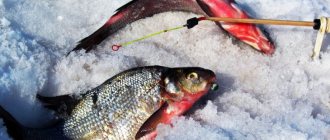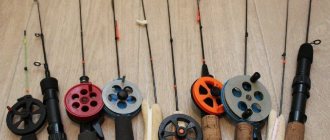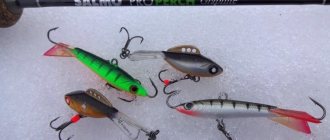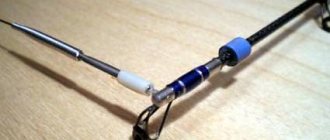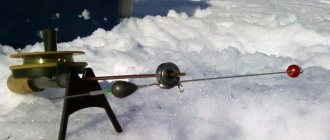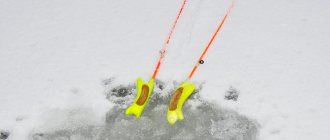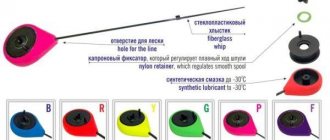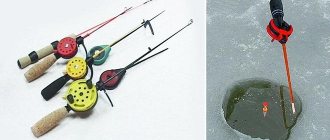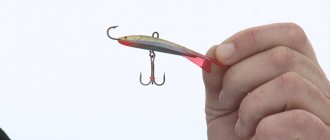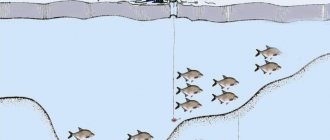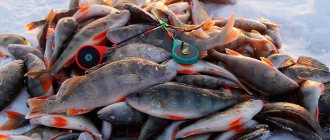Yuri 12/21/2020 443
Have you already selected a bait with a fishing line of the required diameter for your fishing tackle? Now you need to think about how to choose a nod for the jig. After all, the sensitivity of the fishing tackle and the ability to give the bait the necessary mobility completely depend on this.
Let's take a closer look at the question of how to choose the right accessory, thereby ensuring yourself a wonderful catch.
What are they for?
We have already almost answered this question - the nod is a bite signal , and it is this that controls the jig . Fish do not show much activity in winter, and often, having noticed an object shiny like the scales of a fry at the bottom or on the bottom, it will not show much interest in it until it begins to move.
These movements should not be sharp and highly amplitude, it looks unnatural. Therefore, if you simply tie a fishing line with a jig at the end to the whip of a winter fishing rod or even to a stick, your fishing is unlikely to work. It is the shock-absorbing, small movements of the jig, which are transmitted to it from the nod, that attract river inhabitants.
As for the bite alarm, in cold winter water this bite can be so weak and cautious that when fishing with a float it can be overlooked. A well- tuned nod will signal even a tentative approach of the fish .
Gear for catching ripus
The “Flapper” nod for a winter fishing rod is successfully used when fishing for fish of the salmon family on northern lakes.
To make a fishing rod and nod you will need:
- rod "Dolphin";
- one-piece carbon fiber or carbon fiber whip;
- tulip;
- elastic band for attaching the nod;
- nod from a clock spring;
- silicone cambric;
- epoxy resin;
- pliers;
- needle file;
- fishing line;
- insulating tape.
- Remove the hangers from the tulip with pliers and clean it with a file. Raise his ring five degrees up.
- Measure the required length of the whip (everyone chooses for themselves) and cut it off. It is advisable that it be non-hollow, strip off the ends.
- From the whip of the finished fishing rod, cut off the lower part that is attached to the fishing rod, drill a hole in it and glue a new one there.
- Put an elastic band on the other end of the whip, insert and glue the tulip.
- Take a nod from a clock spring, put 2-3 pieces of cambric on it to support the fishing line and stick it into the elastic band, leaving a small tip for fastening. The nod should be several millimeters longer than the whip. Usually its length is 15 cm.
- Secure the tip of the nod after the elastic band with electrical tape.
- Wind the line onto the reel and insert the whip into the rod.
- Thread the fishing line into the elastic and cambrics on the nod. The result was a “Clapperboard” nod for a winter fishing rod.
The guard must be loaded correctly. To do this, use a weight of no more than 4 g.
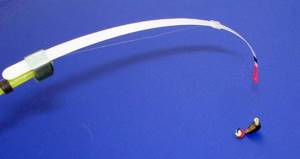
The spring near the elastic is bent back, and the top slightly downwards, ensuring that the nod with the load does not reach the ring of the whip by 1 cm. The working tackle for catching ripus is ready.
Types of nods by weight
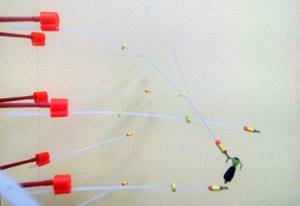
The nod for a winter fishing rod is selected according to the hardness of the base and the weight of the bait:
- light – up to 0.3 g;
- average – 0.4-0.6 g;
- heavy – 0.7-1 g.
If you know which jigs you will use on your upcoming fishing trip, when choosing a guard, test it on this particular gear.
Expert opinion
Knipovich Nikolai Mikhailovich
Zoologist, hydrobiologist. I am interested in fishing at a professional level.
Important! In water, the jig bends the guard less than in the air, so when purchasing tackle, take this circumstance into account.
Also, nods are selected according to length:
- a fast short guard suitable for catching perch and roach;
- But when going for bream or crucian carp, you should choose a longer form.
It is also necessary to take into account the characteristics of the fishing location:
- soft nods are used when fishing in still water on lakes or ponds;
- medium ones are suitable for any current, but the choice depends on the manner of playing with the jig;
- rigid tackle is used in strong currents and at great depths.
In addition, if you are going to modify the purchased nod, take into account the elasticity and weight, adjusted for this. Surely the weight of the nod and its ability to bend will be significantly reduced.
Ice fishing lures
It's easier to find fish in winter. No need for a boat, no grass getting in the way. A couple of holes are needed. Fish are caught using the same baits as in summer.
A common winter bait is bloodworms. These are the larvae of the mosquito mosquito; they can live at sub-zero temperatures. Their bright red color is clearly visible to fish. To attach the fish to the hole, they use different smelling dough; in winter it does not disintegrate as quickly as in summer.
But the main bait for winter fishing is the jig. This piece of equipment, simple to manufacture, has made a real revolution in fishing. In addition to the winter period, you can use it to catch fish vertically in the summer.
For successful fishing, you need to select a jig that matches the fishing tackle and fishing location. The advantage of this bait is that they are easy to make at home. Occupying little space in a fisherman’s arsenal, they catch peaceful and predatory fish without any attachments or bait.
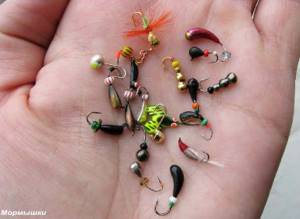
The most catchy winter jigs:
- Balda Beetle.
- Tula Ant.
- Salmo Drop.
- Salmo Nymph.
- Ball Black.
Basic selection rules
With baited tackle
Fishing together with a bait is considered classic winter fishing with a jig, and sometimes the jig is simply used as an elevator, lowering the bloodworm or maggot to the required depth.
However, fishing with bait still requires using the game. The gatehouse is selected accordingly:
- To catch perch and quickly play the tackle, it is advisable to choose a guard that bends 25-30 degrees . Usually these are nods made of lavsan; their length is from 5 to 10 cm, no more.
- For slow play and fishing with a bait from the bottom, you need to choose a nod that bends up to 50 degrees . It is this kind of bend that clearly shows the moment when the bait is already touching the bottom, but the jig itself is not yet there; you can gently tap it on the bottom nearby.
With no rewind

This method of fishing involves active play of the tackle, so the nod should provide it. The best sizes for such equipment are a bend of up to 30 degrees and a length of about 10 cm . For beginners, an ordinary cone-type lavsan is suitable; experienced fishermen prefer various designs made from combined materials from the Salmo Whitefish .
Cambric or holes?
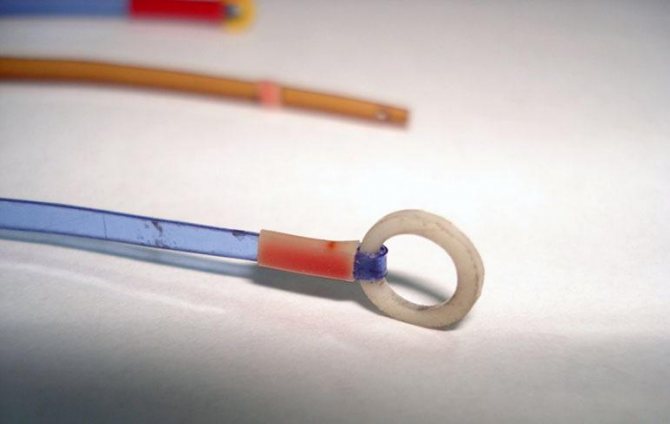
All nods are also divided into two groups according to the method of equipment. In the first group, a small hole is made in the plate into which the fishing line is threaded during installation. In the second, the fishing line is passed through a special cambric installed at the tip of the nod. Let's look at the pros and cons of these options.
Among fans of jigs with attachments, there is a widespread opinion that it is better to use nods with a hole for the fishing line.
The arguments in favor of such a design are as follows:
- Ease of manufacture;
- Relief;
- Smallest residual fluctuations.
This seems to be where the positives end. The disadvantages include the following:
- The hole for passing the fishing line implies the presence of a minimum plate width. When the width of the plate is less than 3 centimeters, there is simply no room left for drilling a hole of sufficient diameter. A wide nod inevitably becomes lame and afraid of the wind.
- Small holes often become icy in the cold when reeling in and unwinding the fishing line. All this wastes time, and sometimes, in the cold, it makes you pretty nervous.
Recommended reading: How to catch grayling with a float rod
Nods for winter fishing, without a hole at the end, but equipped with cambrics, do not have such disadvantages. Although the tip with a cambric is always a little overloaded, this design sometimes plays into the hands of the angler.
A guard with a cambric or ring at the end helps to make high-frequency playing. Swinging by inertia, it makes the animation of the bait more stable and puts less strain on the hand. The line catches less often, which naturally adds comfort while fishing.
Making such a gatehouse is somewhat more difficult than the one with a simple hole. But with a certain skill, this difference becomes unnoticeable.
Nod form
Most gatehouses are made from cone-shaped plates. This is necessary in order to transfer the mass of the jig closer to the tip. The more pronounced the taper of the nod, the higher the oscillation frequency of the bait can be set. Short guards with a pronounced taper are best used for baitless fishing for winter perch fishing. This fish is very partial to the frequent flickering of shiny bait.
A long, thin nod with a slight narrowing makes the animation of the jig smooth and amplitude. Such a game will be more liked by “white fish” such as bream or roach.
When working with small bait weights (up to 0.5 g), the taper of the guard is not particularly important. If fishing is carried out with a heavy devil or goat, taper becomes necessary for proper play.
Conclusion
There are many sizes, shapes, devices and options for equipping gear, as well as the preferences of anglers. Homemade nods beat factory models in most cases. This may be due to more precise customization during manufacturing.
Only one statement remains unchanged. No matter how professionally they are made, the fisherman still holds the fishing rod. An experienced fisherman without bait will catch fish with almost any nodding tackle. Just good tackle will significantly speed up this process and make it more enjoyable.
Selection by material of manufacture
Metal
These nods do not bend very significantly under the load of the jig - on average by 5-10 degrees . When purchasing such a gatehouse, you need to take into account the following features:
- when fishing without a reel, it does not oscillate in response, so rely only on your constant movements;
- it practically repeats the whip, so the game will have to be played with a relatively large amplitude;
- for catching large fish, it is ideal for a large jig and a small spoon.
Curved
It is usually made from a plastic plate or spring. If the nod is initially bent upward, this is a tackle for slow play near the bottom. And the downward bend is intended for sharp jerks, which usually attract perch.
When choosing such tackle, you can test the straight tackle, and then bend the nod at the desired angle up to 45 degrees .
Lavsan
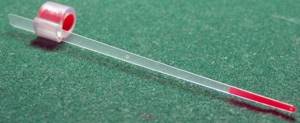
A lavsan nod is inexpensive, durable, highly sensitive and durable. The disadvantages of such gear include its insufficient frost resistance and poor wind resistance.
Expert opinion
Knipovich Nikolai Mikhailovich
Zoologist, hydrobiologist. I am interested in fishing at a professional level.
Important! If you are going to fish with a light jig, the nod should be modernized by slightly sharpening it at the end and shortening it.
Models with frost-resistant additives are now on sale.
Silicone
Its properties are similar to lavsan, it is sensitive and soft, but you should buy several models for the season. They age quickly and lose their elasticity.
Boar bristles
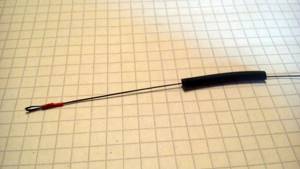
Our grandfathers also used such nods, now they have been replaced by lavsan. The tackle is sensitive, excellent for working with micro jigs.
However, such clog guards resist cross winds. Therefore, some amateurs thread such tackle through a small spring.
Combined
Consists of a base (plastic) and a metal tip. Combines the advantages and disadvantages of both materials.
Well suited for small, frequent play.
Carbon fiber
Often such nods are made independently from old fishing rods and spinning rods. The tackle resists wind and frost well, but when using different types of carbon fiber, it has a different margin of safety.
"Snot"
You don’t have to buy such a nod; it’s easy to make it yourself. The fishing line is wound onto a rod of small diameter, then boiled in water for several minutes. Then the tube is removed, and the ultra-sensitive gear is ready. Just not very durable.
Fishing technique with winter guard
It is important to prepare correctly, choose a fishing spot and study the habits of the fish:
- Select a nod for the weight of the tackle, obtain the desired angle of inclination.
- Determine the fishing location, drill holes. You need to know in advance the behavior of fish at this time of year and in this body of water.
- Depending on the purpose of fishing, the place needs to be stocked.
- Active fishing is carried out with jigs; holes need to be changed frequently.
- Each angler develops his own game tactics and makes combinations. The game can be rhythmic or free, it depends on many factors: time of year, reservoir, selected fish, weight of the tackle.
Basic wiring:
- the jig smoothly sinks to the bottom, after a couple of seconds it rises 5 centimeters;
- at the bottom you can move the bait, tap;
- then the jig rises to a height of up to half a meter;
- the next rise is carried out slowly, with twitches every 5 seconds;
- high-frequency oscillations can be carried out: rises and falls with rapid oscillations;
- the dotted rise resembles the movements of crustaceans, while identical lines are drawn by hand.
It is important to observe pauses , during which bites occur. If simple techniques do not work, you should add variety to the game, change the speed and rhythm.
Which to choose
Each gear has its own advantages, but some of them should be highlighted:
- more durable nods made of metal, carbon fiber or clock spring allow you to fish at great depths and with larger baits and jigs, but they are not suitable for shallow game;
- universal sensitive and durable material - lavsan, but it is poorly resistant to side winds;
- for small games, use nods even from welded fishing line (snot) or nipple, but do not count on their great strength.
Refinement and customization
The game of the jig can be adjusted by lengthening or shortening the guard . Some store-bought models have special length adjusters, but you shouldn’t rely on them too much - in the cold such mechanisms often simply jam.
Dacron gatehouses are especially subject to modification. Usually the tip is sharpened to extreme fineness to give great sensitivity. Some models do not have a taper, but they are also added. Often, nods made of silicone or lavsan are sold without additional painting. In this case, it is recommended to apply several notches to the structure with nail polish - this way the nod will be more noticeable against the background of ice and snow.
Some nuances of the winter nod
The nod cannot in any way be classified as a frozen, unchangeable device for catching fish. You need to look at its constituent parts. The first is the plate, or hair in the case of bristles. The softness of the nod depends on the thickness of the plate: the thinner it is, the better. When it is necessary to reduce the thickness, this can easily be done with sandpaper if the plate is metal. If the nod is made of lavsan, then it can be worked on using a scalpel or other thin, sharp knife.
Cutting the guard under the cone also plays a certain role - it determines how the bait will move in the water (a high frequency of movements is noted with a small amplitude). In practice, the ability to change the length of the nod becomes more important. This can be done by moving the working part of the plate inside the fastener. You need to know that the rigidity of the nod, in addition to the thickness of the plate, is also influenced by its length: the shorter the plate, the stiffer the nod. Consequently, you can use different jigs with the same nod, which is especially important in the winter frost.
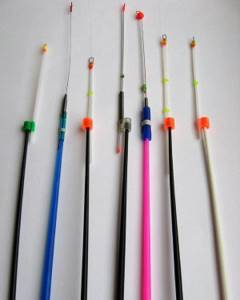
Variety of nods
The shape of the plate can also change when bent, which is possible when using metal and lavsan as materials for bending. They are quite strong, but at the same time you can change the shape of the plate many times, as well as return it to its original position. This allows you to change the game of the bait, doing the same type of wiring, without changing its frequency.
The fastening part of the gatehouse. If it has several components, then the first thing you should pay attention to is the cross-sectional size and strength. The cross-section must be taken into account to ensure a tight fit of the nod on the tip of the six. If the diameter turns out to be larger than necessary, then the nod will shift to the part of the six that is jamming it, sometimes up to 3–5 centimeters. Then it turns out that part of the six and the nod plate peek out from the fasteners, and this reduces the depreciation of the six and distracts the fisherman.
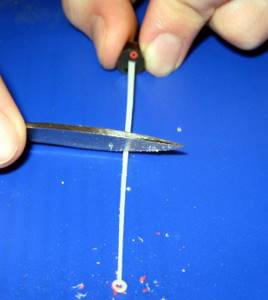
Independent modification of the nod
If such a problem does arise, it can be easily solved. When it is not possible to replace the nod with one that perfectly matches the six, you can simply use a tube of the same color as the six (although this is more aesthetics than necessity; any color is possible). The result will be the required diameter of the six. When choosing a six, you should evaluate how carefully the end rings are made. This is especially important for a metal nod, since if there are nicks or burrs, the fishing line may be damaged. Often it is with this part that you have to work at home, polishing it to an acceptable condition. If there are paint deposits, they must also be removed.
